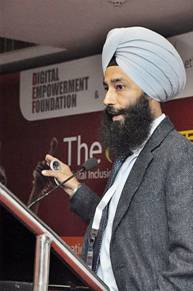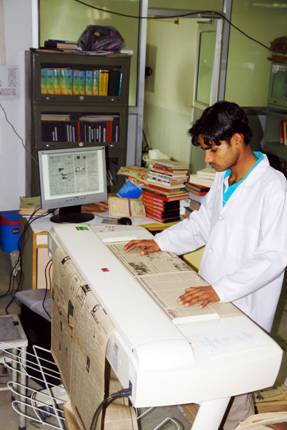Revival of the Punjabi Past
Chandigarh-based the Panjab Digital Library is locating, digitising, preserving and collecting the rich heritage of the entire region
Davinderpal Singh is a man on a mission. He has been working to conserve the heritage of the Punjab by way of preserving and digitising manuscripts, books, official records, newspapers, miniatures, murals, periodicals, paintings, pictures and architecture at the Panjab Digital Library (PDL). After eight years of hard work, Singh has finally digitised six million pages, making PDL the largest repository of manuscripts. With one camera and a computer, and virtually no funds, it was Singh's love for Punjab's rich heritage and culture, and also the fear that it will all be lost in the future, that made him start PDL. Another reason was the destruction of many libraries, in riots, floods and fires in the past, says Singh that made him sit up and realise the valuable role of preservation in today's time.

Davinderpal Singh
"We must ensure that we don't lose the treasure we have in the form of books and manuscripts. We owe it to our future generations," says Singh. Starting with important manuscripts, books and catalogues of the Punjab Language Department and the Chandigarh Museum and Art Gallery, Singh has developed 13 computer applications for the painstaking digitising process, which has several back-ups. With a target of digitising 27 million pages, Singh now has a team in place. The PDL is not limiting its work in Punjab, but also taking up projects in Haryana, J&K and Pakistan. "We mount a digital camera on the manuscript and then transfer these files in JPEG format, ensuring that nothing is lost in the process. Technology has made our Endeavour easier," says Singh, who has now launched the digital online library, for those who have an interest in reading rare documents.
It was by visiting villages, prominent families and social and religious centres, that Singh got some rare documents to digitise. For short-listing villages, Singh personally visited homes to get across to people and explain the concept to them. "Our list includes the first newspaper from Punjab—the Khalsa Akhbar Lahore in Gurmukhi script, a book on the map of Hindustan (1782) and six volumes written by Guru Gobind Singh from Anandpur Sahib from a family of his descendants," says Singh, who adds that personal libraries, letters and diaries of people are a treasure-trove of information. More than 200 years old, and a work of art which Singh has recently digitised, is the Quran Sharif in calligraphy. The text is written in such a way that an image is formed, with each page (150 in all) bearing varied borders.

The collection also includes a rare manuscript of Guru Granth Sahib in Urdu, apart from some from Benaras and letters that open the pages of history. Singh feels that the process will give a new lease of life to the documents, which are on brittle paper and may be lost in time. "We are making sure that the colours are intact and we can capture the texture of the paper," says Singh. He adds that the miniature paintings on Krishna, which are more than 200 years old, are now part of the library. Photographs of all historical places from Peshawar to Himachal captured by Bhai Dhanna Singh on a bicycle in the early 1930s, are also a part of this prized collection.
The ever-expanding online library and funding for the project is being provided by individual donors, with the PDL working closely with intellectuals, library colleagues and museum professionals to identify and deliver digital content which will support current research and encourage new investigations. "We hope people will pitch in with their skills, help us locate manuscripts, adopt a book for digitisation and sponsor a project, so that we can empower our future generations," says Singh.

Scanning Punjabi newspapers
- Parul
Indian Express Nov 28 2011
For more information www.panjabdigiliborg